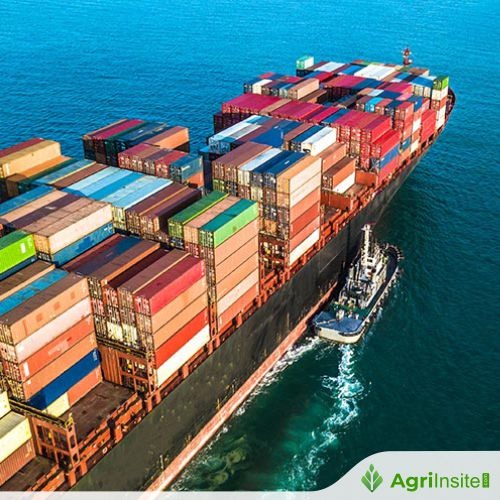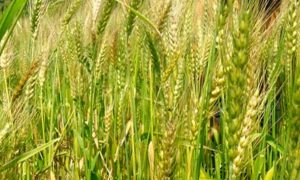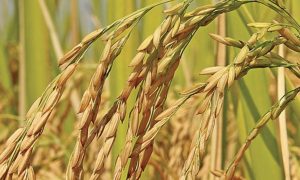Reimagining India’s Agricultural Exports: From Plough to Port

India must shift from water-intensive staples like rice to high-value, sustainable exports such as millets, maize, processed foods, and value-added cotton and meat products. Achieving \$100 billion in agricultural exports requires investment in infrastructure, global marketing, farmer training, and compliance. A value-led, climate-resilient approach can boost farmer incomes, create jobs, and position India as a global agri-export leader.
Agriculture contributes to the livelihood of 40%+ our population, and 18%+ to our GDP. Over the past 3 years, our Agriculture and Allied products’ exports has hovered around US$ 50 billion .
Our share of global Agriculture exports is less than 3%. China, with comparable (rather, lesser) arable land, exports nearly US$ 100 billion worth of agricultural products . This disparity underscores the efficiency and value-addition gap that must be bridged.
The Top 5 countries we export to include US, China, UAE, Vietnam, Bangladesh. The next in line are Saudi Arabia, Malaysia, Iraq, etc.
The top commodities we export include marine products, rice (both basmati and others), spices, buffalo meat, sugar, etc. Marine products’ exports value was US$ 7~8 billion in the recent years. Cotton exports stood at ~US$ 6.8 billion . Rice (both basmati and others) remains a top export item, with its recent numbers hovering ~US$ 10 billion. Buffalo Meat exports have remained relatively stable, ranging from US$ 3.17 ~3.74 billion. Fresh fruits, overall, barely make it to the top 10.
Interestingly, the share of processed food in exports of agricultural products has increased from 13.7% in 2014-15 to 23.4% in 2023-24 . Processed food exports have grown from ~US$ 6 billion in 2018-19, to ~US$ 10.9 billion in 2023-24 .
However, in the face of climate stress, declining groundwater levels, and global market shifts, it is imperative for India to recalibrate its agricultural export strategy. The current export mix, dominated by water-intensive staples like paddy, must gradually give way to nutritionally dense, economically viable, and environmentally sustainable alternatives.
To almost double our Agricultural exports, to reach US$ 100 billion, will take significant efforts across multiple dimensions – policy, incentives, infrastructure development, active engagement with buyers, and above all, a strong will to make it happen.
This paper identifies the emerging and underutilised export avenues in Indian agriculture, evaluates the sustainability of key export segments, and suggests a forward-looking roadmap for diversified, climate-resilient, and globally competitive agricultural exports.
How should the commodity mix change, for sustainable growth in Agricultural exports?
The Case Against Paddy
Rice has been India’s agri-export mainstay for decades. However, the ecological cost of paddy cultivation is increasingly under scrutiny. Paddy consumes over 4,000–5,000 litres of water per kilogram, making it unsustainable in water-scarce states. Continuous mono-cropping leads to nutrient depletion and declining productivity. Also, paddy fields are a significant source of methane emissions.
As climate change exacerbates agronomic stress, relying on paddy exports as a growth lever is not sustainable. There is growing policy and market consensus around diversifying into low-input, high-output crops.
Millets: The Superfood Revolution
Millets have emerged as the poster child of sustainable agriculture. In 2023–24, India exported 1.46 lakh tonnes of millets worth US$71 million, led by products like sorghum, finger millet, pearl millet, and processed millet snacks (source: APEDA ). Millets require 70% less water than paddy, are pest-resistant, and thrive in arid soils. Also, millets are gluten-free, rich in fibre, minerals and protein—ideal for health-conscious global consumers.
The declaration of 2023 as the International Year of Millets by the UN has opened new markets, especially in Europe, North America, and West Asia. This momentum must now be institutionalised with branding, GI tagging, and organic certification.
Maize: A Resilient Commodity with Diverse Demand
Maize is increasingly being used across food, feed, starch, and biofuel sectors. In FY24, India exported 1.44 million tonnes of maize valued at US$440 million , with high demand from Bangladesh, Vietnam, and Nepal. It is less water-intensive and adaptable across agro-climatic zones.
Investments in post-harvest drying, better agronomy practices, and a push towards contract farming can further consolidate India’s position.
Cotton: Rebuilding Leadership through Value Addition
Over the last 7-8 years, Cotton exports from India have fluctuated between US$ 5 ~10 billion. Our farmers deal with global prices volatility and competition from Brazil and the US.
To revive competitiveness, India must shift from raw cotton exports to value-added segments like organic cotton, yarns, and technical textiles. Branding initiatives around “Sustainable Indian Cotton” can enhance price realization.
Buffalo Meat and Animal Products
India is the world’s largest exporter of buffalo meat, with FY24 exports reaching US$3.74 billion. Primary markets include Vietnam, Malaysia, and Indonesia.India’s meat sector adheres to OIE and Codex standards, making it globally competitive. With rising global protein demand, particularly in Asia, India can grow its meat exports with improved traceability and logistics.
Additionally, categories like animal casings, hides, and dairy products (e.g., paneer, ghee) are gaining ground, with scope for premiumisation.
Processed Foods: The Next Frontier
Processed foods accounted for US$ 10 billion in FY24 exports , making up over 23% of India’s agri-exports. The shift towards packaged and branded foods in global markets is irreversible. India’s diverse culinary tradition, low-cost manufacturing base, and growing organic segment give it a unique edge.
In markets such as the US, ~50% of the food exports is processed. In India, there is scope to increase the share of processed exports to ~40%.Shrimp exports alone could grow to nearly US$ 10 billion with more processing as ready-to-eat items.
What we need to work on, to achieve our exports goals
Customer Engagement: We need to critically analyse top food importing countries around the world, and keeping in mind their local procurement needs and the Indian produce strengths, identify gaps to be addressed. It is important to diversify beyond our existing large customer base and establish a strong presence in large and profitable markets such as Europe, Australia.
Once we prioritize a few key target countries, we must invest heavily in engaging with these customers. It could require establishing international presence of a government body such as APEDA or similar entity. Both government and the industry (export bodies, Agricultural traders, organizations such as NABARD, etc. from India) need to work closely with these importing nations, understand their requirements and then work with the farmer ecosystem as per the requirements. For instance, we need to pay special attention to sanitary and phytosanitary (SPS) compliance in export destinations like the EU and the US.
If it needs any government-to-government negotiations such as FTA, then those steps need to be taken. The engagement may require investments in trade shows abroad (e.g. Gulfood, Anuga, Biofach), or inviting the large buyers to India. It may require promotional schemes and incentives – either to the buyers abroad, or to the farmers in India. A strong campaign on, say “Taste of India” (drawing inspiration from Thailand’s “Kitchen of the world” push), may be required to promote Indian Agriculture and food exports.
A heavy marketing budget should be planned for all these activities, just the way a typical, large Food / FMCG business would plan its global expansion.
Product Development: As mentioned above, once we understand the importer requirements, we need to work with the farmer ecosystem accordingly. These may be new products (e.g., avocado) or new clusters (e.g., North-east) or just a new push within an existing cluster (e.g. Grapes / Nasik). If we look at the length and breadth of Indian agro-climatic zones, we grow a wide variety of “not very popular in India” items such as rambutan, dragon fruit, avocadoes, etc. If we get the right market linkage, we can scale such items. Eventually, the product mix must be such that the per-unit-value of the trade goes up from current levels.
The product specifications need to be translated into agronomy practice definitions and standard operating procedures. Whether it includes more sustainable practices (less water usage or lower emissions) or involves technology embedding such as blockchain-for-traceability, all those necessary elements need to be incorporated.
GI-gagging is already being explored; more should be considered, with the clear intent to demand a premium wherever the customer recognizes our produce specialty. The government must actively work with its network of KVK (Krishi Vikas Kendra)s and their extension workers as well as FPOs and other farmer organizations to ensure that necessary changes happen on the ground.
Supply chain Effectiveness: As the core commodity production process gets streamlined, the next step is to ensure that there is appropriate infrastructure support across the supply chain. Starting from right kind of solar-powered cold storage units at the farm level, to cold storage facilities, to pack-houses, to reefer trucks to advanced packaging and processing units is critical.
The customer needs for processed food items would require us to invest in large processing factory set ups. With our agricultural production levels, India can easily establish ten mega food parks exclusively for export-oriented processing. These should incorporate integrated facilities from warehousing to quality testing and export documentation.
We also need adequate testing facilities (for globally valid certifications – GAP, HACCP, organic, etc.). Treatment facilities (e.g., vapor treatment) also need to be set up, to ensure the products meet global phytosanitary requirements.
One common issue faced by Agriculture exporters is connectivity to airports or seaports. Secondly, not all ports are well equipped to handle Agriculture exports. When looking at the supply chain, every single link from the farm until the product reaches the customer location, needs to be critically analysed. Fresh infrastructure investments may be needed; and these may be needed to be beefed up with incentives and subsidies around transportation costs. PPP investments should be strongly encouraged. Soft loans and grants to FPOs for setting up their own units is another way. Export Credit Guarantee Corporation (ECGC) scheme should be expanded, with special focus on Agricultural exports. Government should use viability gap funding to make investments in critical infrastructure more attractive.
Switching from air freight to sea freight offers significant advantages in terms of cost effectiveness and environmental sustainability. Sea freight provides a more economical option for transporting large volumes of goods over long distances, reducing shipping costs per unit. Additionally, it has a lower carbon footprint compared to air freight, aligning with global efforts to minimize environmental impacts and promote sustainable supply chain practices. The right protocols need to be developed, from on-farm-practices to packaging and logistics.
The development of 50 integrated export logistics hubs across major agricultural production regions could be a major boost to exports. These should provide end-to-end solutions including aggregation, sorting, packaging, pre-cooling, and customs clearance.
In case there is any technology investment needed from the government side to support these activities – e.g., usage of satellite data and IoT sensors to ensure timely and accurate agronomy advice – those necessary investments must be stepped up. There would certainly be a need for a central “war room” with real-time insights coming from global developments, weather pattern changes and latest production trends in the fields.
Approximately US$ 8-10 billion is needed across inputs, infrastructure, processing, and demand enablers. These Infrastructure improvements could generate 7-10 million jobs along the agricultural export value chains.
People Development: Whatever direction we take, we must consciously invest in training and capacity building of the entire ecosystem.
The bureaucrats should be trained on global best practices, how large MNCs in the food / FMCG space operate, how other governments (such as China) expand the business footprint.
The extension workers and KVK employees need to be trained on global standards, any new practices required, and how to address weather unpredictability when adopting new methods.
Needless to say, the farmer needs the maximum training if there is a new requirement from the customers, or there is a need to adhere to stringent processes or quality standards.
And all these different stakeholders need to be trained on new technological possibilities.
Conclusion: From Volume to Value
India’s agricultural export strategy must evolve from a volume-driven to a value-led approach. Instead of chasing incremental gains in traditional exports like rice or sugar, we must invest in sustainable, climate-resilient, and high-growth commodities—such as millets, maize, buffalo meat, processed foods, cotton value chains, and horticulture.
Doubling exports is will directly contribute to the goal of doubling farmers’ income. In addition, the food processing industry will also grow.
Reaching US$ 100 billion in agricultural exports is not a distant dream. With coordinated reforms, strategic investments, and an unrelenting focus on execution (and not just intent), we can turn this dream into reality.
To Read more about Agri News continue reading Agriinsite.com
Source : Rural Voice

















